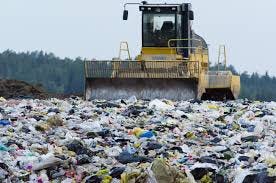Why Journalism Matters
Investigating the final destination for fast fashion. Western banks sent hard cash to Russia before Ukraine invasion plus the life and times of pink slime
4 minute read
GPS tracking shows how fast fashion creates waste mountains around the developing world

No doubt WJM readers around the world have dutifully deposited their surplus and used clothing at recycling centres and collection bins in the optimistic belief that these textiles will be used again or remade as other items of clothing.
Unfortunately, like so many other aspects of ‘recycling’, passing on used clothes too often turns out to be delusional wishful thinking about the impact of worldwide over production and mass waste disposal.
A Greenpeace investigation in Spain (also published in the El Pais newspaper) reveals that the reality is a far cry from what we all would like to imagine.
Greenpeace Spain discovered that ‘fast fashion’ clothes, largely manufactured using cheap labour in the global south (in countries like Bangladesh and Vietnam) takes a journey of thousands of miles to be worn for a brief time in Western countries before finding its way on to a growing mountain of decaying or burning garbage in Africa, or elsewhere in the developing world.
The waste clothing problem in Spain is particularly acute. A 2024 report by the European Environment Agency (EEA), concludes that in 2020 the European Union generated 6.95 million tons of textile waste, about 16 kg per person but only 4.4 kg (domestic and industrial) was collected separately for potential reuse and recycling.
Spain, however, is above average in textile waste generation exceeding 20 kg per person per year, yet only selectively collects 2.1 kg per person per year )
In the report for El Pais published late last year, Beatriz Lecumberri outlines the ambitious and ingenious scope of Greenpeace’s research.
She writes: “To support this data, Greenpeace Spain placed tracking devices on 23 items of clothing and followed their journey for a year after depositing them in collection containers at Mango and Zara stores in various Spanish cities, between August and September 2023.
Five times around the world
“Each item travelled an average of 9,000 km (almost 5,600 miles), and in total, the 23 travelled a combined 205,121 km (127,455 mi), which is equivalent to going around the Earth five times.”
Greenpeace found that the geolocated garments wound up in 11 different countries, most of them in the Global South, mainly in Asia and Africa.
“Five ended up in Togo, Cameroon and Ivory Coast. One pair of pants travelled 22,000 km (13,670 mi) in 215 days, from Madrid to Abidjan, via the United Arab Emirates, until its trail was lost.”
Greenpeace describes the recycling system as ‘collapsed and uncontrolled’ with many of the clothes unfit for reuse because of poor quality materials containing microplastics and other pollutants.
As Lecumberri explains: “A ‘symbol of this perverse model’ is Black Friday, when purchases skyrocket due to lower prices, warns Greenpeace. The NGO stresses that this pattern of clothing consumption is ‘an environmental time bomb’ that cannot be sustained without the countries of the Global South being there to, ‘first, produce our clothing, and, second, manage the waste generated by the clothes we throw away’.”
Greenpeace notes that the textile industry is responsible for 10 per cent of global greenhouse gas emissions, and insists that the situation has worsened in just a few years. The export of used clothing from the European Union (EU) has tripled, rising from 550,000 tonnes in 2000 to almost 1.7 million in 2019.
While the amount of fashion waste has increased, the composition of clothing itself has changed because synthetic materials like polyester and nylon, which are more polluting and poorer quality, have been incorporated. Substances that are dangerous to health, such as cadmium or mercury, have also been detected in clothing.
New legislation
New EU legislation comes into force in the this year to help control the problem, but Sara del Río who co-ordinated the research for Greenpeace Spain explains what more has to be done.
“… If a company is fully responsible for the impact of its waste, it must also be responsible for ensuring that it does not end up in an African country, burned or in a landfill, and therefore it must commit to producing fewer and higher quality garments.”
But she adds that this is ‘not what the brands are advocating’ stressing that Greenpeace believes that returning to the production levels of 25 years ago would already represent a substantial change in the right direction.
Greenpeace has published a detailed analysis of their investigation research and methodology. Click on the link below to get a fuller picture.
Reference
El Pais on Greenpeace investigation
Greenpeace: A Second Life for Your Clothes?
4 minute read
Western banks shipped billions in cash to Russia before the Ukraine invasion

While the Kremlin was moving tanks and massing troops on the Ukrainian border in preparation for the invasion of February 24 2022, Western banks helped wealthy Russians and Russian agencies to fly crates of foreign currency back home.
Prominent among these banks was Raiffeisen Bank International, Brink’s and Bank of America according to a report by the Organised Crime and Corruption Reporting Project (OCCRP) and their collaborators Paper Trail Media.
(The report was written by Graeme McNaughton, Brian Fitzpatrick (OCCRP), and Frederik Obermaier (Paper Trail Media)
Although before the war moving foreign currency to Russia and elsewhere was not uncommon, trade data reviewed by journalists showed those three global banks moved more than $12 billion to OCCRP and Paper Trail Media shows that the three institutions moved more than $12 billion worth of foreign currency to Russia just before the full-scale invasion of Ukraine in February 2022., mostly in dollars euros, and Swiss Francs.
As the OCCRP report states: “Austria’s Raiffeisen Bank International (RBI) was by far the biggest money mover, sending 189 shipments worth a combined $10 billion.
“None of those shipments were illegal, as currency export bans were not imposed before the full-scale invasion. Brink’s and Bank of America said they no longer do business in Russia, while RBI is winding down its operations. All three institutions emphasized in comments to reporters that shipments had not violated any laws.”
The cash all went to a Russian entity importer-exporter TBSS, a now-sanctioned Moscow importer-exporter who shares headquarters with the Russians customs authority. Very shortly after the invasion both the European Union, and the U.S., outlawed the export of euros and dollars to Russia.
“Records point to a dramatic escalation in large imports of currency into Moscow starting on January 11. That was just a week before Russian troops began arriving in Belarus, which borders Ukraine, in what was seen as a precursor to the invasion.
272 shipments
“From January 11 to February 23, a total of 272 shipments — holding an average of $44.78 million in cash — were imported to Russia by TBSS. This amounted to more than triple the average shipment size TBSS had received in the years between 2017 and 2021, according to the data.”
While this massive transfer was going on the American administration was in talks with American banks about potential sanctions.
“This extraction of cash from Western financial institutions at a time of intense political risk should have raised red flags,” said David Szakonyi, an associate professor of political science at George Washington University.”
Szakonyi said the uptick in shipments of cash to Russia could have served several purposes, coming as they did just before the assault on Ukraine.
“Moscow needed to shore up cash to pay for its planned invasion,” he said. “And if Russia sincerely believed it would take Kyiv, that requires co-opting politicians, business people, other powerful actors within Ukraine and committing them to a new Russian government, or Russia-backed government in Ukraine.”
The trade data showing these cash shipments comes from a company called Import Genius specialising in import-export data which gets it from the Russian government.
“The data shows at least 10 RBI cash deliveries to Moscow arrived on or after February 24, just as Russian tanks were advancing on Kyiv and warplanes bombed Ukrainian cities. Invoices show the shipments were sent just before the invasion.
“The RBI did not carry out any cash deliveries to Russia after the start of the war,” Christof Danz, a bank spokesperson, said in response to an inquiry by Der Standard and Paper Trail Media.
Euros, dollars and Swiss francs
“In line with the ECB's requirements, we accelerate the reduction of the business volume in Russia,” said RBI CEO Johann Strobl in a July 2024 statement, adding that they are working on “the sale of Raiffeisenbank Russia."
According to the data RBI and Brink’s shipped euros and U.S. currency, as well as some Swiss francs while Bank of America only shipped American currency from the U.S.
Bill Halldin, a Bank of America spokesperson told reporters: “We fully comply with all economic sanctions and required disclosures on currency transactions.”
He added that “Bank Notes transactions in early 2022 were consistent with historic volumes when you include deliveries from all locations, not just the United States. Your data relies on shipments from the U.S. only, which provides an incomplete view of our past deliveries.”
However, Halldin did not explain why the data showed a spike in shipments of U.S. currency from the U.S. in early 2022.
Halldin said the bank “significantly curtailed our business in Russia after the 2014 invasion into Ukraine,” and now has “virtually no financial exposure in Russia” and “no business activities in Russia today.”
The Brink's Company is also American and specialises in the secure transport of cash, said it “suspended all business with Russia in early 2022.”
Janis Kluge from the German Institute for International and Security Affairs, emphasised the importance of the role played by TBSS in Russia
“Foreign currency in cash is always helpful in a war, especially since the attack on Ukraine was expected weeks in advance,” he said.
Reference
5 minute read
Beware the news fakery of Pink Slime journalism

As WJM readers will have read here about the many threats facing the practice of reliable journalism in general and investigative journalism in particular.
But when we introduce one of threats as ‘pink slime’ , it conjures up images of horror movies and science fiction ogres oozing gooey menace from our TV screens.
Unfortunately, pink slime is not some sort of fearful fantasy from a dystopian future. It is a very real and present danger for the practice of journalism and those interested in--and reliant on-- the veracity of news and public discourse. We need to know about it, and learn to recognise it. In many respects pink slime represents the real fake news so often decried by political demagogues.
Unexpectedly perhaps, the well respected Pima County Library based in Tucson, Arizona offers us a useful and concise summary and explanation of pink slime journalism on its website.
“Pink Slime Journalism is a phrase that describes low cost and poor-quality online local news. Mimicking responsible news by appearance, tone, and hyper-local content, these sites pretend they are the same as a legitimate local news source, but often target local audiences and areas with the promotion of commercial, political, and ideological content that do not follow accepted and reliable journalism standards—that is, unbiased, independent, and reliable local news with named and traceable sources.”
(By the way, the term pink slime is derived from the meat processing industry, referring to a meat by-product that is used as a filler in processed meats, then sometimes passed off as higher quality meat.)
Sharp decline
The advent of the pink slime phenomenon is taking place against the background of a sharp decline in traditional local newspapers and outlets, particularly in the US. Not only are the numbers declining but they lack the resources to adequately cover local events and carry out investigations, thus leaving yawning informational gaps in local communities.
Research by Northwestern University shows that there is now little to no reliable local news reporting in over half of US counties with advertising now going on line to companies like Google and Meta (Facebook).
As the economic base for local legacy media declines, so in parallel does consumer trust in news media continue to plummet. As the Reuters Institute for the Study of Journalism outlines in a 2024 research report: “… across the world, much of the public does not trust most news most of the time. While there is significant variation from country to country and from brand to brand, in this year’s report, just 40% of our respondents across all 47 markets say they trust most news.”
And there is clear evidence that pink slime sites are filling the gap.
As the PIMA report explains: “[In the US] as of April 2024, NewsGuard, an organisation that finds and tracks disinformation in news sites, identified 1,197 pink slime news sources, and by June 2024, they found that pink slime sites outnumbered legitimate online local news sites.
“Sponsors of pink slime sites exploit this opportunity, and while they seemingly fill a need, they often are promoting a point of view and spreading disinformation, further undermining public trust in journalism.”
In our March 5 edition WJM related the story of Good Daily, an online company that runs a chain of ‘local’ newsletters circulating across the US featuring content about local events and personalities. Good Daily operates in 47 states and 355 towns and cities across the US.
But an investigation by the journalism studies outlet Nieman Lab at Harvard University discovered that Good Daily is run by one person and uses an AI system to generate its content.
There are no bylines from local reporters or any other local contacts on the websites. In fact, the front pages of each of these newsletters are virtually identical except for summaries of local news stories.
Good Daily is not the only such network that masquerades as a local, non-partisan news outlet.
Metric Media
Meet Metric Media, another national network which purports to champion local news.
In 2019 an investigation by the Tow Center for Digital Journalism at Columbia Journalism School in New York discovered ‘at least 450 websites in a network of local and business news organisations, each distributing thousands of algorithmically generated articles and a smaller number of reported stories’.
“Of the 450 sites we discovered, at least 189 were set up as local news networks across ten states within the last twelve months by an organisation called Metric Media.”
These ‘local’ news outlets turn out to be part of a burgeoning eco system of more than 1,200 websites that are trying to fill the void left by the decline of local newspapers.
As the New York Times reported at the same time: “Yet the network, now in all 50 states, is built not on traditional journalism but on propaganda ordered up by dozens of conservative think tanks, political operatives, corporate executives and public-relations professionals.
“The network is largely overseen by Brian Timpone, a TV reporter turned internet entrepreneur who has sought to capitalise on the decline of local news organisations for nearly two decades.”
Both Republicans and Democrats have funded these types of sites according to the Times.
“Liberal donors have poured millions of dollars into operations like Courier, a network of eight sites that began covering local news in swing states last year. Conservative activists are running similar sites, like the Star News group in Tennessee, Virginia and Minnesota.
“But those operations run just several sites each, while Mr. Timpone’s network has more than twice as many sites as the nation’s largest newspaper chain, Gannett.
“While Mr. Timpone’s sites generally do not post information that is outright false, the operation is rooted in deception, eschewing hallmarks of news reporting like fairness and transparency. Only a few dozen of the sites disclose funding from advocacy groups.”
Who is to say what impact these sites had on voting in swing states which returned Donald Trump to the White House in 2024?
According to the Northwestern University research cited earlier,in news ‘deserts’-- with no single source of professional local news --‘Trump won in a landslide’ even though his overall margin in the popular vote was less than 1.5%.
Exploiting faith
As the Columbia Journalism Review commented in 2019: “Websites and networks can aid campaigns to manipulate public opinion by exploiting faith in local media. The demise of local journalism in many areas creates an information vacuum, and raises the chance of success for these influence campaigns. The strategy is further made possible by the low cost of automating news stories, repurposing press releases… and replicating design templates, as well as the relative ease with which political or single-issue campaigns can obscure their funding and provenance.”
But don’t despair. The Pima County Public library website has some helpful advice for identifying ‘pink slime’ in your news diet.
Look for balance in the stories.
Check ownership and funding: If a site is vague or secretive about who runs it or where its funding comes from, be wary.
Investigate the bylines.
Be sceptical of overly sensational headlines.
Read laterally—that is, find several different sources about the same topic.
Reference
Pima County Library: Pink Slime Journalism
Columbia Journalism Review: Pink Slime: Partisan journalism and the future of local news
It’s free to subscribe and you can cancel anytime, so give it a try!
Contact us on greatjournalismwjm@gmail.com
Follow us on Facebook and Twitter
facebook.com/whyjournalism matters
X-twitter @JournalismWhy





